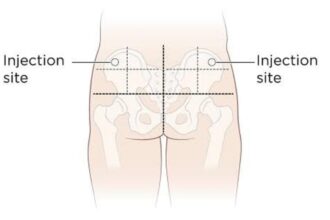Sacroiliac joint dysfunction and sciatica. The secret iliac joint pain may be missed or misdiagnosed as sciatica, because the Si joint causes symptoms in the lower back, in the buttock, and in the leg which mimics sciatica pain.

Caution not all sciatica symptoms are caused by lumbar disc herniation and Other conditions may mimic lumbar disc herniation and present itself as sciatica.
Briefly, some symptoms of sciatica usually are caused by a nerve root irritation due to lumbar disc herniation, lumbar spinal stenosis, or it may be due to sciatic nerve irritation if the patient has piriformis syndrome.
There are numerous extra spinal causes of sciatica that makes the diagnosis of the cause of sciatica difficult for the treating physician and makes the treatment challenging. When you evaluate a patient with sciatica make sure to exclude other sciatica impersonators such as AC joint dysfunction. The Si joint does not cause a true sciatica or a lumbar ridiculosity.
However, the symptoms of sickle iliac joint dysfunction can mimic radiculopathy or can mimic piriformis syndrome. Two. Sciatica has a spine origin and occurs due to compression of the nerve roots by the herniated disc.
Performer syndrome can cause sciatica of non spine related origin. Pain originating from the side joint is usually unappreciated, underdiagnosed and misdiagnosed and it is attributed to other sources of pain such as the spine and the hip.
Sacroiliac joint dysfunction

Lumbar Spine SI Joint Hip
Hip disease. Lumbar stenosis symptoms and SI joint symptoms may coexist and overlap confusing the clinician. When you have an Si joint pain, you want to know if the Si joint is the predominant pain generator or not. There is wide variability in the clinical presentation of the sacral iliac joint from localized pain and tenderness around the iliac joint to radiating pain that looks like sciatica.
And the patient may have more than one pain generator And there should be differential diagnosis with spine conditions and with hip conditions. Sacroiliac joint pain can be similar to facet joint pain. Sciatica This condition or discogenic pain. The sacroiliac joint evaluation should be part of low back pain evaluation. Always check the patient for Trendelenburg gait leg length discrepancy and scoliosis pain of SI joint origin is usually not in the midline. The pain is usually at the side and it is usually below L5 level.
The patient can present with sciatica like pain. The pain will be running down the thigh or even beyond the knee with occasional groin pain. The pain will be worse with sitting with weight on the affected side. Pain will occur with stepping up or going upstairs. Pain will occur even when lying in bed with difficulty in sleeping and changing positions.
Sciatica

Pain will occur with putting pressure on the joint or loading this joint. The symptoms sometimes can be similar to a herniated disc or a compressed nerve, because there is a lot of nerves that run around the sacroiliac joint. The diagnosis is usually done by a combination of location of the pain clinical tests and examination and diagnostic history.
When asking the patient “where does it hurt”?
The typical response of the patient is right here! and the patient will point directly at the posterior superior iliac spine or below it. The posterior superior iliac spine is rich with posterior sacral network of nerves, and it is close to the sacroiliac joint where there is a lot of nerves, including the lumbosacral plexus, (which is the origin of the sciatic nerve).
Because the nerves run around the skull iliac joint, the patient can present with sciatica like pain, with buttock pain radiating down the thigh and the leg.
The lower part of the secret iliac joint is synovial, which can be inflamed. This inflamed synovial fluid can leak outside the joint and irritate the surrounding nerves and create sciatica Like symptoms. Usually there is no specific cause for the sacroiliac joint pain. The cause is usually difficult to determine. Pointing the finger at the site of the pain is called the 14 finger test.
When the 14 finger test confirms the area of the pain just medial and inferior to the posterior superior iliac spine you will have to start multiple exam maneuvers and special tests to narrow the diagnosis to the sacred iliac joint With multiple exam maneuvers and special tests, you need three positive tests, and you will have to warn the patient that these tests may cause pain. These are the tests commonly used. And it is called provocative test because it reproduces the pain of the patient. Ask the patient if he perceives the same pain or different pain.
The compression test and the thigh thrust test are considered the most valuable tests. However, the Faber test is the most commonly used test. The Faber test is done by flexion abduction and external rotation of the hip. Provocative tests are painful and you need to warn the patient about the pain that they may experience. Three or more positive provocative tests will need further investigation to confirm the diagnosis. In addition to these provocative tests, you will do a straight leg raise and neurological exam to exclude disc herniation and you will do hip exam to exclude hip diseases.
When the patient has a positive history positive 14 test, positive provocative test, negative lumbar and hip exam and negative X-rays, then you recommend diagnostic injection of the Si joint with diagnostic injection of the Si joint. You can usually use ultrasound or fluoroscopy with diagnostic injection of the Si joint. If you have more than 75% reduction of pain following a single injection that means the primary site of pain is the sacroiliac joint.
The injection may give you a temporary relief of symptoms. If the patient has minimal or no immediate response, then this is a negative test. Then look for other source of the pain. Treatment of Si joint pain is usually non-operative and will include anti-inflammatory medication, physiotherapy, pelvic belt and injection which can be diagnostic or therapeutic.
Injection gives about 60% success rate in pain relief at six months. Injection can be repeated re injection in six months or 4 in 1 year. Surgery is done by fusion of the sacroiliac joint which will lead to symptomatic improvement. The fusion will improve the pain, the disability and the quality of life of the patient.



